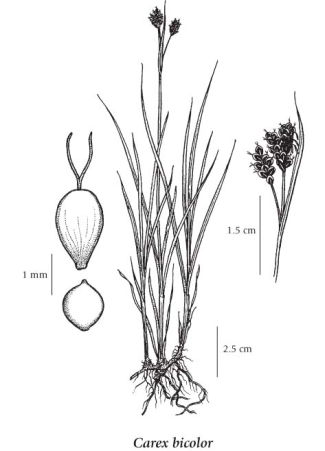Carex bicolor Bellardi ex All.
two-coloured sedge (twocolor sedge)
Cyperaceae (Sedge family)
Introduction to Vascular Plants
two-coloured sedge (twocolor sedge)
Cyperaceae (Sedge family)
Introduction to Vascular Plants
Species Information
General:
Perennial, loosely tufted herb from short rhizomes; stems 5-30 cm tall, longer than the leaves.
Leaves:
Sheaths tight; blades 3 to 6 per stem, flat, borne on the lower 1/3 of the stem, 1-2 mm wide, the lower ones reduced.
Flowers:
Spikes 3 to 5, 4-10 mm long, borne close together at the top of the stems, with female flowers, except the terminal spike with a few male flowers at the base, short-stalked; bracts subtending the female spikes with short sheaths, scalelike, the lowermost barely reaching the top of the inflorescence and with blackish earlike lobes at the top of the sheath.
Fruits:
Perigynia egg-shaped, 2-3 mm long, 0.7-1 mm wide, inflated, dull green to bluish-white, nerveless, with a powdery surface, beakless; female scales egg-shaped, pointed to rounded at the tips, shorter and narrower than the perigynia, purplish-black to reddish-brown, with greenish midribs and translucent margins; stigmas 2; achenes lens-shaped, 1.2-1.4 mm long.
Illustration

If more than one illustration is available for a species (e.g., separate illustrations were provided for two subspecies) then links to the separate images will be provided below. Note that individual subspecies or varietal illustrations are not always available.
Illustration Source: The Illustrated Flora of British Columbia
Ecology
Ecological Framework for Carex bicolor
The table below shows the species-specific information calculated from
original data (BEC database) provided by the BC Ministry of Forests and Range.
(Updated August, 2013)
The table below shows the species-specific information calculated from
original data (BEC database) provided by the BC Ministry of Forests and Range.
(Updated August, 2013)
| Site Information |
Value / Class |
||
|
Avg |
Min |
Max |
|
| Elevation
(metres) |
359 | 33 | 685 |
| Slope
Gradient (%) |
9 | 3 | 28 |
|
Aspect (degrees) |
77 | 20 | 350 |
| Soil
Moisture Regime (SMR) [0 - very xeric; 4 - mesic; 8 - hydric] |
4 | 2 | 7 |
| Modal
Nutrient Regime
Class |
C | ||
| #
of field plots species was recorded in: |
6 | ||
| Modal
BEC Zone Class |
BAFA | ||
|
All BEC Zones (# of stations/zone) species was recorded in |
BAFA(2), ESSF(1), SBS(1) | ||
|
Source:
Klinkenberg 2013
|
|||